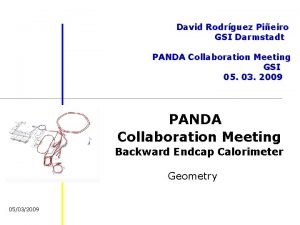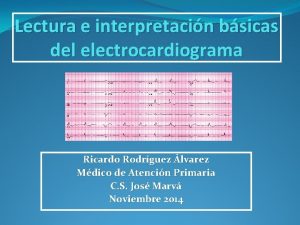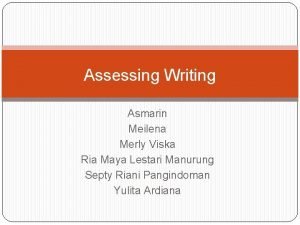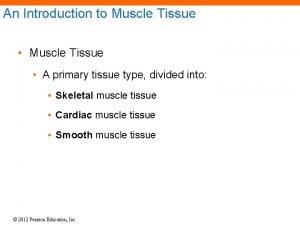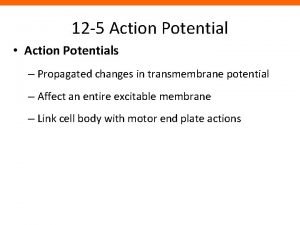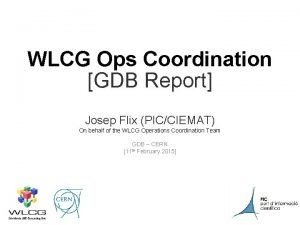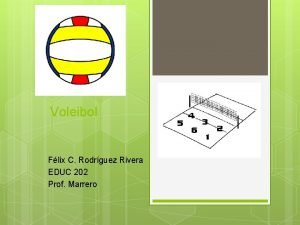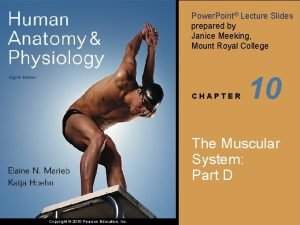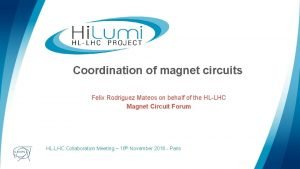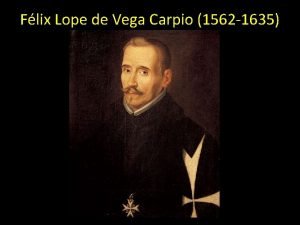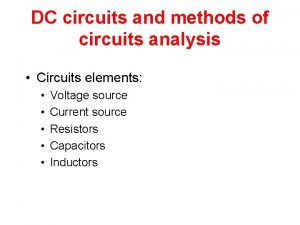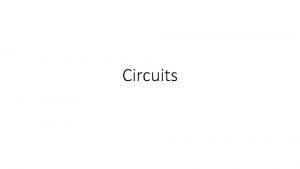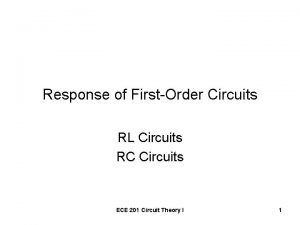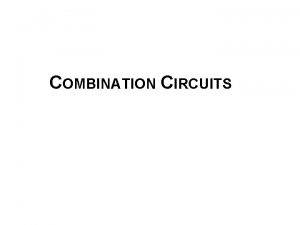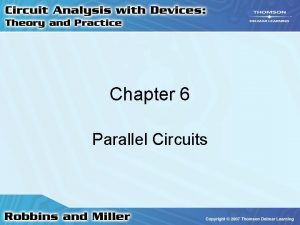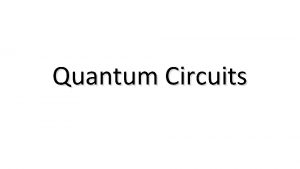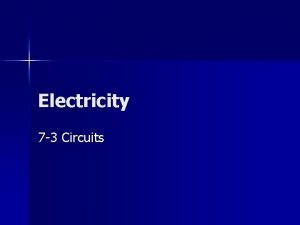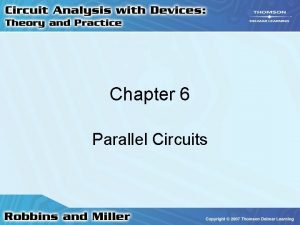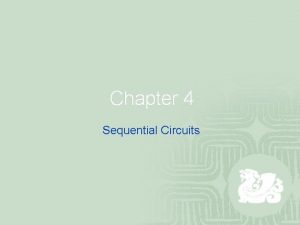Circuits description and requirements Flix Rodrguez Mateos on

























- Slides: 25

Circuits description and requirements Félix Rodríguez Mateos (on behalf of the HL-LHC Magnet Circuit Forum) HL-LHC Cold Powering Review – 3 rd July 2017

Outline 1. Introduction to the HL-LHC Circuits’ powering and protection Ø Circuits’ layouts, schemes and key parameters Ø The role of the Magnet Circuit Forum 2. Baseline and inputs to cold powering design (Inner Triplet quads circuit) Ø Current ratings, quench loads, d. I/dt Ø Voltage withstand levels Ø Documentation 3. Some (other) follow-ups from the Internal Circuits Review 4. Conclusions Felix Rodriguez Mateos 2

Introduction Felix Rodriguez Mateos 3

§ § The definitions and optimization process for the HL-LHC superconducting magnet circuits started in the fall of 2015 Since then, two reviews have taken place: § § Conceptual Design Review of the Magnet Circuits for the HL-LHC (2123 March 2016); https: //indico. cern. ch/event/477759/ HL-LHC Magnet Circuits Internal Review (17 March 2017); https: //indico. cern. ch/event/611018/ Through the last months, since the second review, a considerable effort has been delivered in order to advance finalizing the configuration of HL-LHC magnet circuits The work together with the WPs involved is done within the framework of Magnet Circuit Forum (MCF), [26 meetings have taken place so far since July 2016, including some topical meetings] All this work has produced a baseline that is going to be outlined throughout this presentation The focus will be set on aspects directly impacting the cold powering. Felix Rodriguez Mateos 4

Felix Rodriguez Mateos 5

The HL-LHC MCF (Magnet Circuit Forum) Mandate § § § § The Magnet Circuit Forum (MCF) is a regular meeting where all aspects related to powering and protection of the HL-LHC circuits are discussed, in particular the ones pertaining to the optimization of circuit layouts and definition of protection means. Subjects in the agenda are defined in close collaboration with the relevant WPs. Interface aspects between systems are clarified through meetings at the forum. To this end, a documentation plan has to be developed and completed. The aim is to prepare a set of functional interface specifications that can be used as input for the design (technical specifications) of the different systems. Assessment on realistic failure scenarios and required mitigation strategies on a global basis is part of the activities of the MCF. The MCF is the meeting where aspects related to high voltage withstand levels are discussed and harmonized in order to define an Electrical Quality Assurance plan globally The MCF reports regularly to TCC and takes up any relevant discussion within the domain of cold/warm powering and protection of the HLLHC circuits in collaboration with the relevant WPs. One of the recommendations of the March 2016 review on HL-LHC Magnet Circuits was: “… to realize close and regular interaction (communication) between the involved experts and work-packages. This could be possibly done by setting-up of a dedicated working group or by using existing structures to discuss circuit integration and protection on a regular basis and to identify the optimum scheme for each magnet circuit system. ” MCF’s website Felix Rodriguez Mateos 6

Inner Triplet Circuit Felix Rodriguez Mateos 7

Definition of a conservative scenario § • In order to define of the different s. c. parts of Q 2 b quenches suddenlythe andrating completely (4 poles) • the 15 ms detection and validation circuit in terms of current, MIIts, d. I/dt max, one has to • look 1 ms CLIQ for afiring worst case (conservative) scenario • 5 ms heater firing § • We haveanalysis selected a conservative scenario where one Sensitivity w. r. t. parameters full magnet quenches by effect of beam TS 1 A TS 3 TS 2 B Nov 2016 C D E Felix Rodriguez Mateos 8

Standard quench case Quench simulations § Quench occurring in a spot of a magnet followed by quench detection and validation (15 ms) and quench protection triggering (1 ms, Outer QH+CLIQ) § Initial conditions: Worst case of current in trims, nominal and ultimate currents § Sensitivity analysis: Influence of the worst distribution of strand parameters (RRR and Cu/non-Cu ratio) § CLIQ delays: Influence of a delay in the triggering of one CLIQ unit Conservative quench cases § Quench occurring suddenly in one entire magnet followed by quench detection and validation (15 ms) and quench protection triggering (1 ms, Outer QH+CLIQ) leading to the quench of the other magnets § Initial conditions: Worst case of current in trims, nominal and ultimate currents § Sensitivity analysis: Influence of the worst distribution of strand parameters (RRR and Cu/no. Cu ratio). § For the case at ultimate current (representing the highest values reached in all simulations), less conservative (more realistic) cases of sudden quench of parts of one magnet: inner layers of all four poles in one magnet; a few turns on the horizontal mid-plane. § Quench detection time: changing the 15 ms reference time to see effects Felix Rodriguez Mateos 9

Peak Values @ Standard cases - Nominal I vs Ultimate I 16, 5 17, 8 15 10 5 4 2, 3 4 3, 7 2, 3 4, 3 Lead A Lead B Lead C Lead D 0 Nominal current - 16. 47 k. A Ultimate current 17. 8 k. A 300 250 200 174 196 220 251 Lead A 195 150 197 175 117 110 100 48 50 Lead B Lead C Lead D Lead E 0 Nominal current - 16. 47 k. A Ultimate current 17. 8 k. A MIIts in the leads - Comparison between nominal and ultimate 35 30 28, 3 28 29, 1 Lead A 25 MIITs Currents in k. A 20 Peak current rates through the leads Comparison between nominal and ultimate Current rates in k. A/s Currents through the leads - Comparison between nominal and ultimate 20 Lead B 15 Lead C 10 5 Lead D 2, 2 0, 6 1, 8 1, 9 0, 5 2, 1 Lead E 0 Nominal current - 16. 47 k. A Ultimate current 17. 8 k. A Felix Rodriguez Mateos 10

Peak Values @ Conservative case - Nominal I vs Ultimate I Current rates through the leads Comparison between nominal and ultimate Currents through the leads - Comparison between nominal and ultimate 16, 5 17, 8 Lead A Lead B 15 Lead C 10 4, 9 5 6, 1 5, 6 2, 8 Lead D 6, 8 Lead E 2, 4 250 Current rates in k. A/s 16, 5 0 222 206 211 197 200 Lead A Lead B 150 94 84 102 100 96 114 116 Lead C Lead D Lead E 50 0 Nominal current - 16. 47 k. A Ultimate current 17. 8 k. A MIITs in the leads - Comparison between nominal and ultimate MIITs Current in k. A 20 35 30 25 20 15 10 5 0 31, 5 31, 4 29, 2 29, 1 Lead A Lead B Lead C Lead D 1 2, 7 4, 9 Nominal current - 16. 47 k. A 0, 7 3 5 Ultimate current 17. 8 k. A Lead E Felix Rodriguez Mateos 11

Conclusions from IT simulations & analysis in a nutshell § § for standard cases, over-currents can go up to 4. 3 k. A and 2. 2 MIITs (approx. nominal and ultimate currents included) for the conservative scenario, those values could go up to 6. 1 k. A (nominal) and 6. 8 k. A (ultimate), and 5 MIIts (nominal and ultimate approx. ) § these numbers are obtained considering a full magnet suddenly quenching in its whole volume § § § 7 k. A current capability in s. c. would suffice for not quenching the conductors within the s. c. link or bus bars 5 MIIts is the highest quench load the s. c. link or bus bars would see The analysis covers the whole spectrum of operating conditions, from low to ultimate current Felix Rodriguez Mateos 12

Inner triplet – Baseline May 2017 “The panel considers that the presented powering circuit is a robust solution, provided the 2 k. A and 120 A SC trim cables in the superconducting link can be upgraded to a rating of about 5 -6 k. A and 5 MIITs” Trim cables will be designed for 7 k. A and 5 MIIts Felix Rodriguez Mateos 13

Cold Powering Functional Specification for HLLHC Inner Triplets and D 1 A reference document has been prepared with the main parameters related to § The Inner Triplet electrical circuits § Ratings as defined by transient studies § Voltage Withstand Levels for electrical insulation APPROVED Felix Rodriguez Mateos 14

Inner triplet circuits – Baseline ratings * Conservative numbers, they require detailed simulations Felix Rodriguez Mateos 15

A recap on the definition of voltage withstand levels from previous Reviews: Felix Rodriguez Mateos 16

Electrical insulation test levels for link and bus bars Rating (k. A) Worst case voltage to ground during operation (V) Acceptance tests of components to ground (V) Insulation test voltage of system to ground (V) RT NOC Leakage current per component (µA) Test duration (s) 18 900 4600 2300 460 1080 ≤ 10 30 7 900 4600 2300 460 1080 ≤ 10 30 2 540 3160 1580 316 648 ≤ 10 30 0. 12 40 1160 580 220 360 ≤ 10 30 0. 035 900 4600 2300 460 1080 ≤ 10 30 Table: Test voltage of leads and cables and calculated highest voltage to ground during operation. For the 18 k. A and 7 k. A cables, the highest voltage is estimated to be 700 V (across the high resistance of Q 1 a trim) + 100 V (sum of voltages across crowbar and cables resistances) + 100 V (superconducting cable in the link resistive along the full length). For the 2 k. A and 0. 2 k. A cables, an energy extraction of 500 V is considered (worst case scenario). For the 0. 12 k. A circuits the crowbar voltage across the power converter is taken into account for the calculations. RT: Room temperature NOC: Nominal operating conditions Felix Rodriguez Mateos 17

Other follow-ups from the recent Review Felix Rodriguez Mateos 18

Optimization: Cold Diodes 2 options τ = 100 ms 7 k. A τ = 100 s 18 k. A Capable to dissipate the energy of the full magnet string τ = 100 s Felix Rodriguez Mateos 19

§ The Internal Review Panel (March 2017) recommended to carry out studies related to the integration of cold diodes in a way to further optimize the circuit as cold diodes would bring in clear advantages: § § Decoupling of warm and cold parts of the circuit Avoiding the large current unbalances flowing through the sc link Making the circuit more robust with respect to variability of scattering of quench resistances in the different magnets due to delays in protection actions and/or inherent magnet properties (RRR, Cu/non-Cu, strand diameter, quench location, etc) But diodes have to be qualified with respect to: § § § Integration in the cold environment (bus bar section for options being studied at present) withstand the current pulses according to the circuit time constants tolerate with margin the radiation doses expected at their final position (roughly 1 order of magnitude above LHC) Felix Rodriguez Mateos 20

Follow-ups from Internal Review – Matching section Item 1. 2. 3. The relevant groups (TE-MSC, TE-CRG) should launch a task force effort in order to agree on the requirements and the procedure for the dismantling and the reassembly of the DSL [In case of a dismantling of the DSL, the corrector SC cables should be kept at a rating of 600 A to include a possible change from MCBY correctors to MCBYY correctors] Connection in series for four Q 4 corrector magnets (2 circuits with two magnets each) be adopted in order to reduce the leads from 16 to 12 and hence eliminate After discussions with work packages involved, it has the local powering Action WP 6 a WP 3, WP 6 a, agreed WP 6 b, WP 7 been that both Q 5’s and Q 4’s correctors will be powered individually Q 5 correctors to be powered individually by providing local powering for the missing leads WP 6 a Felix Rodriguez Mateos 21

Courtesy: S. Claudet (TE-CRG) and V. Parma (TE-MSC) • Not in the scope of this Review • Studies will start with the goal of a final decision by end of 2017 Felix Rodriguez Mateos 22

Conclusions Felix Rodriguez Mateos 23

§ The HL-LHC circuits baseline in terms of powering and protection has been consolidated through two Reviews and the teamed work within the Magnet Circuit Forum where all the relevant WPs are represented § Inputs to the design of cold powering have been defined and are documented § Optimization in the case of the inner triplet main circuit is ongoing and should not have a major impact into the cold powering baseline (provided decisions are taken with sufficient anticipation) § A few open points require a follow-up but there is no showstopper identified as of today Felix Rodriguez Mateos 24

Thank you very much for your attention Felix Rodriguez Mateos 25
 Quero agradecer a antarctica pelas brahmas
Quero agradecer a antarctica pelas brahmas Aportaciones de adolfo lópez mateos
Aportaciones de adolfo lópez mateos Current in a parallel circuit
Current in a parallel circuit Olivia rodrguez
Olivia rodrguez Veronica rodrguez
Veronica rodrguez Lizbeth rodrguez
Lizbeth rodrguez Lizbeth rodrguez
Lizbeth rodrguez Julieta rodrguez
Julieta rodrguez David rodrguez
David rodrguez Manuel rodrguez
Manuel rodrguez Ricardo rodrguez
Ricardo rodrguez David rodrguez
David rodrguez Lizbeth rodrguez
Lizbeth rodrguez Ria rodrguez
Ria rodrguez Refractory period
Refractory period M flix
M flix Titin
Titin Action potential
Action potential Nlt flix
Nlt flix Hello flix
Hello flix Felix gonzalez chicote
Felix gonzalez chicote Apuestas marca blanca
Apuestas marca blanca Eva fidalgo elices
Eva fidalgo elices Nlt flix
Nlt flix Que es bompeo
Que es bompeo Adductor hallucis longus
Adductor hallucis longus








